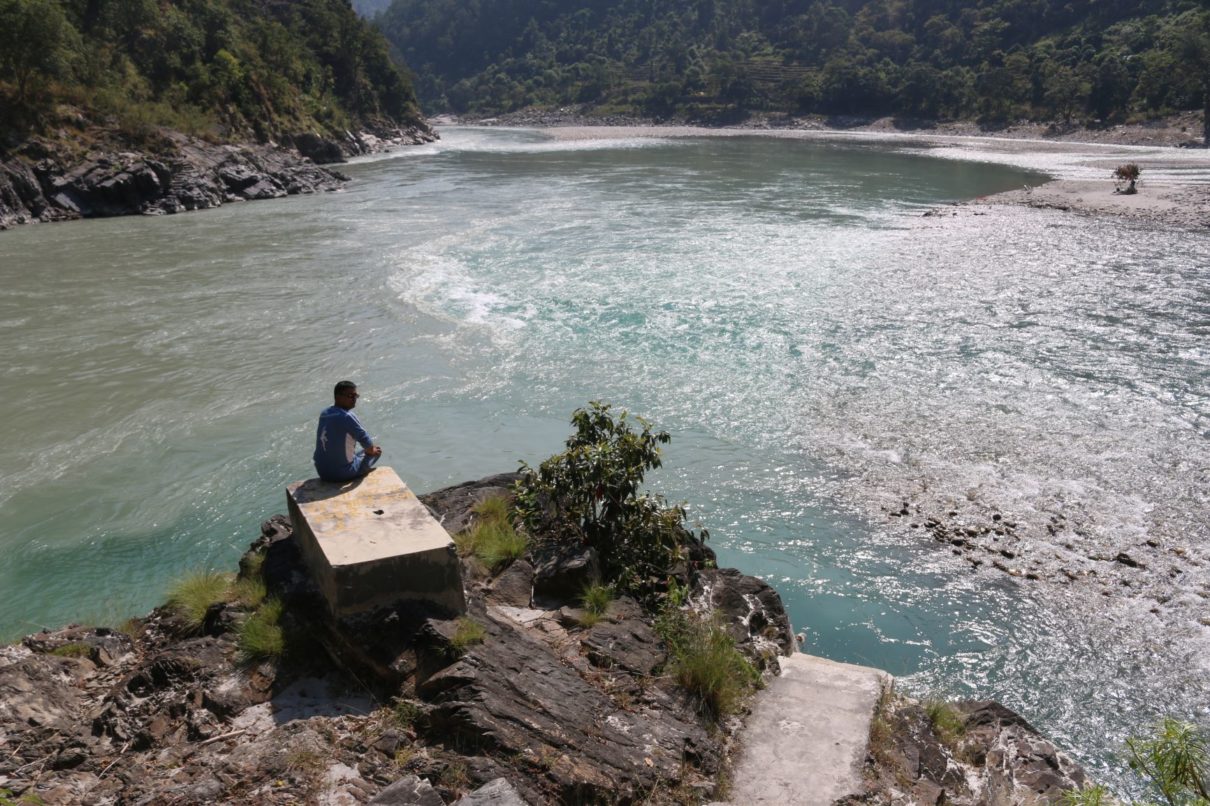It called for venturing the rivers to gather first-hand home knowledge about the coveted gamefish. In seven years, my craze took me to a horde of rivers in the east and west of Nepal in quest of the legendary fish.
Subsequently, way back in 2008, one of my explorations took me to the mighty Sapta Koshi, in far-east Nepal to Trivenighat, Dhankuta district, some eight kilometers from the renowned pilgrimage, Barahachhetra (20 km from Dharan). I had a fisher friend from Dharan, Tek Bahadur Limbu, as a company and a guide. The site for my angling was Trivenighat at the confluence of three rivers: Sun Koshi, Arun, and Tammar, a three-hour grueling hike from Barahachhetra along a narrow foot trail scary for a city slicker like me. There was no motor road then, only a narrow trail hewn into the side of hills—only a couple of feet wide at some places—with more than 500m sheer drops to the roaring Sapta Koshi. As we slogged along, the sight was breathtaking, however. I often stopped to gawk at the great expanse of water that churned into raging whitewater rapids, cascading eddies over rocks, giant boulders, some car-sized, and calm, inviting pools. And the deep rumble of the Koshi music to the ears. The swollen river after the confluence at Trivenighat is called Sapta Koshi, a merger of seven rivers. Curiously, Triveni is also a meeting point of three districts: Dhankuta, Bhojpur and Udayapur. Previously, Trivenighat was also known as Majhinighat, named after a Majhi (fishing community) lady. As the folklore goes, before a suspension bridge over Tammar, the lady used to ferry travelers across the river in a dug-out canoe. Locals told me that once she shuttled the late King Mahendra across. At the time, she did not have a ghost of an idea that her fellow commuter was the king incognito. The small settlement was populated mainly by Rais, especially of the Bantawa and Chamling clans, who lived by fishing, raising goats, and selling bamboo, but were given the harsh land with scanty crops. Because of the rugged, arid terrain, rice cultivation was hardly any. For sustenance, the locals mainly grew corn, their staple food. To them, a handful of rice meals a year was nothing short of a luxury; many could not even afford it. After a tough slog in the March heat, we finally arrived at our destination; all shagged out. Starved to death, we stopped by a tea shop and immediately wolfed down on dal-bhat with the plates heaped up. As we ate, my eyes kept traveling to the confluence clearly in sight from the eatery. Following a much-needed respite, Tek and I, armed with our fishing gear, advanced to the confluence where Tammar met the merger of Arun and Sun Koshi (also called Dudh Koshi by the locals). I could not wait to cast my rod. Since Tek knew the best spots like the back of his hand, I let him call the shots, and we got cracking positioned 300 yards apart. While he chose the raging confluence, strewn with big rocks and boulders, I began casting way downriver. We planned to use metal spinners as a lure for the day's angling. I had no clue if Tek was lucky to land some mahseer, but I had no bite even after three hours of working the river up and down, casting-and-retrieving my lure. I knew Golden Mahseer was elusive and hard to come by. So I kept on with my casting like clockwork. Then, my eyes caught a strange sight some 200 yards upriver. I watched incredulously the distant two figures floating down the river, what looked like—on their feet. What on earth was that? I asked myself! I hastily retrieved my fishing line—and waited with bated breath, my camera on the ready. As it turned out, the duo was on a flimsy raft. And then, I froze—because one of the guys got out of sight as he fell overboard in the churning waves. Stunned, it left me at the edge of my seat. Then what seemed like ages, I saw the poor guy's bobbing upper body hanging onto one end of the bouncing raft as the choppy waters slapped him. He tried to clamber up, slipped, and fell again into the raging water. He kept trying but could not heave himself overboard. Then, to my horror, I lost him between the leaping waves. Blast it! I started almost praying as I furiously clicked away on my camera. I jumped next! I spotted him again struggling hard to join his mate, who seemed helpless trying to steer the unwieldy raft. “Come on, come on, you can do it, dude!” I muttered to myself. And then—a miracle happened! He clambered aboard! I sighed in relief and waved madly at them as they bobbed up and down and shot past me almost at arm's length. I was a witness to the above fateful drama way back in March 2008. I learned later that those guys were local villagers ferrying bamboo down the big river to sell, a common practice among the riverside communities to supplement their earnings. The villagers lash together the bamboo in bunches of 25 to 30 stalks by a jungle vine locally called birali and stripped bamboo skins called choya and shape them into a cone to serve as a raft, an ingenious craft handed down to them for generations. The trussed-up bamboo is taken apart and sold upon arrival at the destination. I also learned the confluence at Triveni, held in awe and fear by the rafters, had long been the site of numerous accidents, resulting in severe injuries and even fatalities. [email protected]











